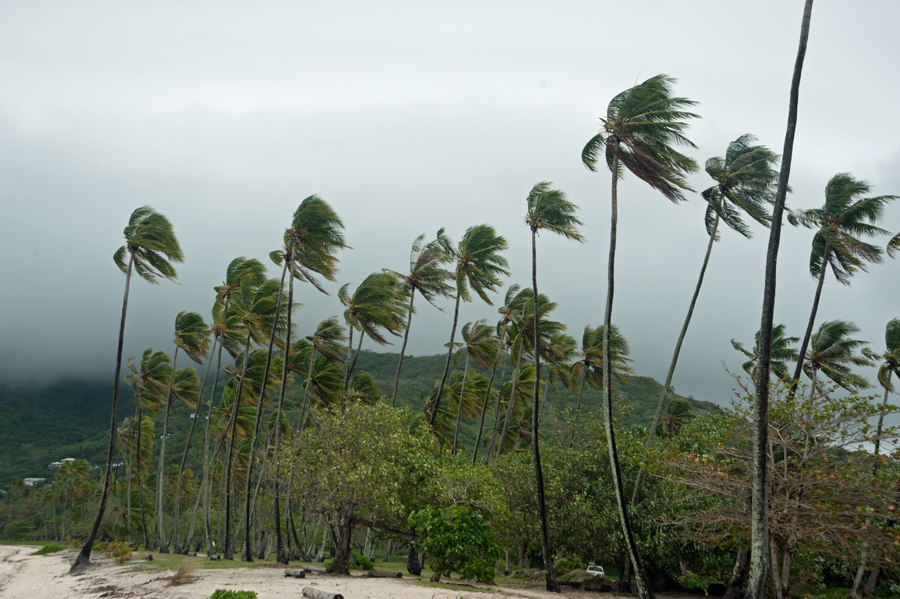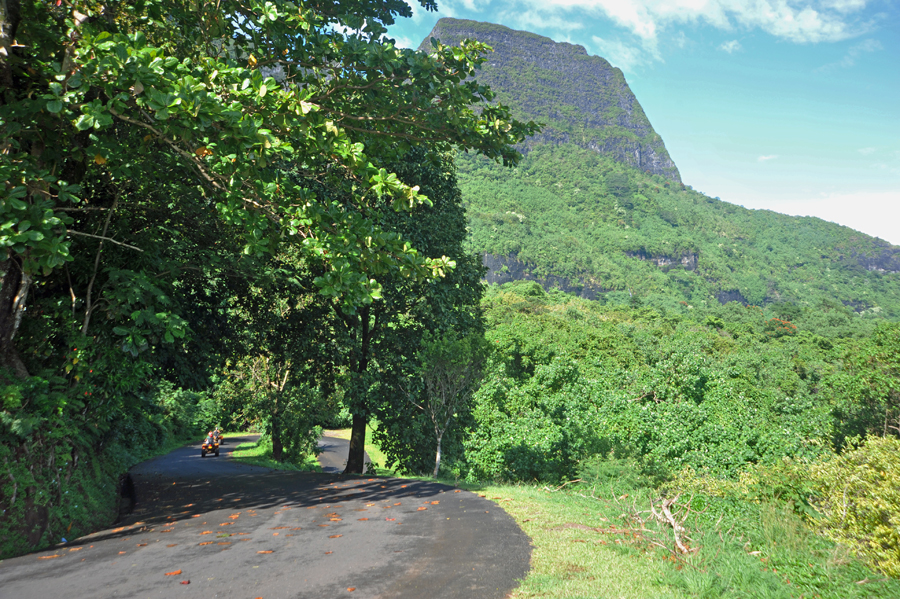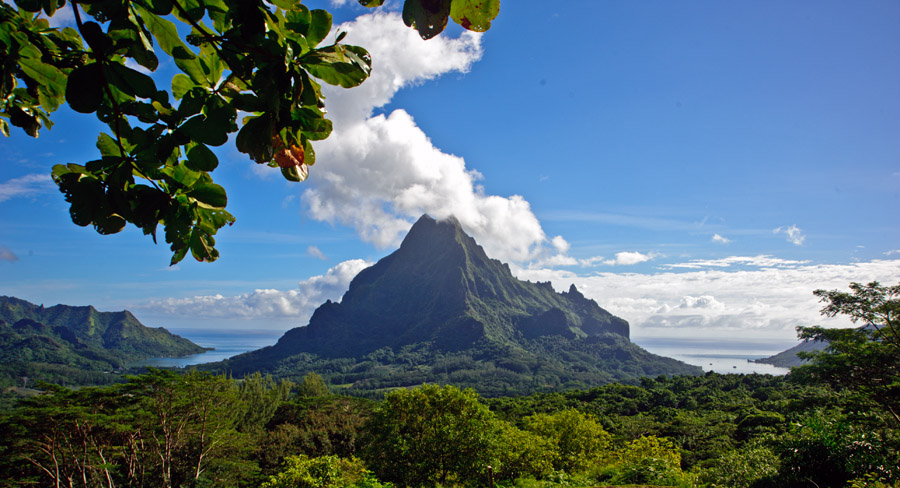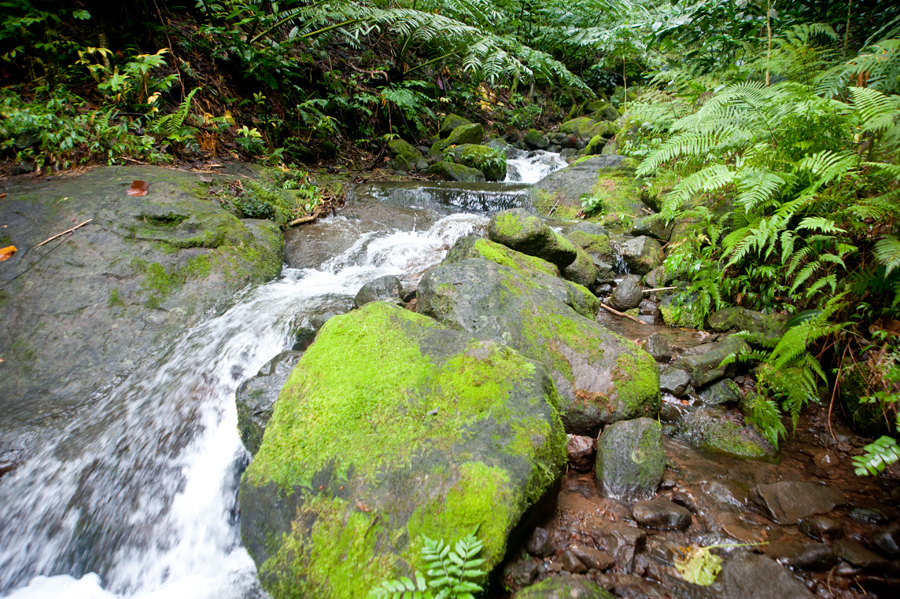Link to: Mo’orea – Part 1
Chances are you’ve never heard of this beautiful place called Mo’orea unless you have traveled to Tahiti. Surrounded by a turquoise lagoon, the island is utterly stunning.
Thunder and lightning are not common in this area of French Polynesia. Our first night in our rental cottage we were awoken by a passing storm. We knew a big mara’amu was due in but the storm noise and loud thunder surprised us. The cottage has a metal roof which amplifies the sound of the rain inside our bedroom. The next morning we awoke to perfectly clear skies and the wonderful smell you get after a good hard rain. Our breakfast arrived promptly at 8:00 am. Téa, our host, steps inside with a tray of goodies, coffee, and juice. She has an incredible happy personality and the warmest smile. She asks about our plans for the day. Her English is very good. Our plan is to do what we do best, roam about aimlessly and see what happens.
At the driveway facing the street in our tiny Chinese hot rod with the big orange dot, we decide to turn left. It isn’t long before the skies start to cloud over as forecasted. We expect off and on rain for the day. Just down the street is a small shopping center. It has the cutest gas station and a couple of restaurants. We make note of the restaurant as we want to eat out at least one night while here. Today happens to be a holiday so much of the island’s businesses are closed.
As we make our way around the island we never seem to get very far before another photo opportunity presents itself. I am convinced I could spend a couple of months here taking pictures of the same things over and over. The island takes on a completely different personality as the weather changes. Massive mountains can disappear into the clouds and the lagoon can change from gray to turquoise as the sun comes out. Colors appear and disappear with the weather.
At one point in our travels, we notice a sign with a camera on it meaning down the side-street is a picture opportunity. It turns out to be a church. As part of the church grounds, there is a large swimming area, a pier, and a pavilion. A group of boys are playing football under the pavilion to escape the drizzle. They see the camera. We are obviously tourists. One of them asks, in French, where we are from. I explain in my very poor French I have a limited grasp of the language. He immediately starts to speak with perfect English. Is there anybody on this island who isn’t bilingual? The fact is, these kids are not bilingual. They are, in fact, tri-lingual: French, Tahitian, and English. These are the languages taught in their public schools.
Rather than say we are from America, the Covid-19 capital of the world, we explain to the boys we live on a boat and have been on Tahiti for a few months. They immediately warm up to us and joke about for a little while. Cindy read how Polynesians have a great sense of humor and love to poke fun at one another. We are finding this to be very true. It often takes little encouragement to get going. Are you going to be football players, I ask. They assure me they are going to be superstar footballers. I had better get my picture now before they get famous.
We both try to improve our language skills while here. To complicate matters, there seem to be at least three words for everything. For example, when looking at a sign or a map, there is a French name, a Tahitian name, and often a local name for the place. Hello in Tahitian is Ia orana (yo-rah-nah), in French it is Bonjour. The islanders use both interchangeably. We find we get a bigger smile when we great someone in Tahitian.
While trying to improve our Tahitian vocabulary, Cindy asks what the word is for “you welcome”. So, for instance, when we are at the grocery store and the cashier thanks us in Tahitian with maururu (mah-roo-roo) it would be nice to respond appropriately. This question drew a blank. Apparently they are no Tahitian words for this phrase. The correct response, we were told, is to say maururu back.
One of the things becoming immediately apparent to us during our circumnavigation of Mo’orea, there is a lack of beaches. Based on Polynesian beliefs dating back before any occupancy of the islands, the locals have land and water rights. The wealthier people or chiefs owned land in the best area and fertile valleys. The poorest people had fishing rights on the outside of the reef. Everyone else fell somewhere in-between. The land is owned from the very tip on the mountain to the outside of the surrounding reefs.
As with most cultures, the land is passed down in the family. Many boaters not understanding this tidbit, do not realize when anchoring inside the lagoon, they are in fact anchoring in someone’s front yard. While technically people have a right to anchor boats in approved areas, it is a good idea to try to find the local “chief” and meet them. Often, knowledgeable polite boaters will offer a gift. The gifting of something very small, such as a jar of chutney, can work wonders and improve the boater’s experience. It is also a very good idea for cruisers to be conscious of where they leave their dinghy. Leaving it on the beach might upset a few locals since sandy areas are scarce on this particular island.
So where are the beaches? Many of the primo waterfront locations have houses built on them with land ownership going back hundreds of years. We are not talking palatial mansions. Many of the waterfront homes are very basic. Some look almost uninhabitable. A few have a small beach and the owner will charge for access. It is a small fee but a reminder nonetheless it is privately owned.
I find it a little bit regrettable the most beautiful beach on the island is owned by the Sofitel hotel and the beach is off-limits to the locals unless they purchase a day pass for 7,150 xpf (about US$70) per person. There is a public beach in the same area. Of course, it’s not quite as nice. I have a feeling this was a compromise made when Sofitel acquired the land for the hotel. The Sofitel is one of those postcard hotels you see with bungalows on stilts over the lagoon. Cindy and I had an interesting conversation about this.
Why would anybody want to stay in a room over the water, I said. It is so far from everything, I bet they don’t even have ice machines way out there and by the time room-service arrived, it’d be cold. I thought it would be very boring to look out the window and only see the water. And to top it off, I’d bet the further out a person is, the more expensive the room would be. I looked at the OMG rates. It can cost about US$1,000 per night. Yowza! That’d be a tough number for me to swallow for a hotel room.
Cindy’s point of view: She’d love to stay in a room like this. She can imagine swimming from her private deck or watching fish through the glass floor. She explained how breakfast is delivered by a person on an out-rigger boat covered in flowers. If she were to travel traditionally by plane to such an exotic location as Mo’orea staying in a unique place such as this would be fun. This would be where she would want to stay and thinks it’s worth every penny.
We normally agree on most things but on this one we were at opposite ends of the spectrum. All I can say, I think I might have dodged a bullet. The hotel is just now re-opening after being closed due to the travel restrictions here. Thank goodness our options were limited to which AirBnB cottage we were going to rent.
Driving up to Belvedere lookout is an absolute must-do on Mo’orea. It is the highest point a person can rise to by car. There are hiking trails that go higher. The view from this overlook is glorious. It doesn’t take long to navigate the road upward. The road is about a car and a half wide. Perfect for our Chinese hot-rod which is about half the size of a real car. Our engine strains as we make the climb. There is a bit of a grinding sound. If it were my car, I’d be concerned.
We meet some oncoming vehicles. On some parts of the road, it is impossible to move over very far. There can be a sheer drop at the edge, no guardrails. On the other side is a cliff. A couple of times I thought I might be buying Avis a new driver’s side-mirror. But luckily, we made it unscathed.
Once again, I find it amazing more tourists are not lost on Mo’orea by driving off the road. I catch myself more than once looking off at the amazing view that keeps getting better as we get higher. At the top, we park being careful not to run over a chicken. I don’t think we have visited a country yet that doesn’t have an abundance of free-range chickens. Perhaps, maybe on Bonaire. They had free range donkeys. Donkeys are easier to see than chickens. But, donkeys don’t move out of the way.
At the top of the hill, we have an interesting conversation. Cindy says, have you noticed how quickly we slide into our no stress mode now? She is referring to the days when we were both a part of the rat-race and when going on vacation it seemed to take at least four days for us to become relaxed. Interestingly, I had been thinking about the exact same thing. Looking over the view of Mo’orea will do this to a person. There is without a doubt more Zen in our lives now. Whenever we take a vacation away from the Puffster, we can become relaxed almost instantly.
During our first year of cruising, we met a couple in the Bahamas, David and Lea Ann. The lifestyle was new to us and no Zen was to be found, yet. Like most cruisers who start out, we started in vacation mode. There is always a bit of a rush to see what is around the corner. Then the pace, for most, tends to slow down. David and Lea Ann were in their tenth year of cruising when we met them on their boat for drinks one evening. Upon arrival, I somehow expected the “Where have you been, what did you do for a living, let me tell you about me” conversation. But instead, David and I talked about the colors of the sunset. After which, we discovered we both had a love of music. The conversation became more relaxed as the evening went on. I knew then, this type of relaxation was what lied ahead for us, someday. Being at this lookout and taking in the vista, I think we might be at their level.
I spot a trail and decide to explore. I hear the sound of a waterfall. About ten minutes later down the trail, I make a decision to turn around and go back. It has rained recently and the rocks on the trail are wet and slick. In addition, they have some leaves covering them. Stepping on wet leaves on wet rocks is like walking on ice. I think it is a good idea to let Cindy know I am going to follow the trail for a bit. As much as I like Mo’orea, I have no plans of dying here.
Back at the Chinese hot-rod, I coat myself in bug-spray and tell Cindy where I’m going and I should be about half an hour ‘ish. She tells me to take the InReach, our satellite communication device. She really is the clever one. I find a decent hiking stick and set off into the trees. My Nikon SLR camera is slung in the middle of my back. This means, if I fall, I need to fall on my face. Protect the camera at all costs!
The trail to the water is treacherous. I’m covered in mud and I haven’t even managed to fall down, yet. This is definitely not your average tourist hike. The sound of the water gets louder and the path takes a downward trend. At one point, I wonder how many tourists are lost down the mountain. Is there a sort of tourist graveyard at the end of the trail? I can see the local farmer at the bottom pointing upward and warning his family, “watch-out, here comes another one”. I wonder what the Polynesian translation is for raining tourists. A fall here would most certainly result in injury.
I would really love at this point to post an incredible picture of a huge waterfall. You know the kind I talking about. I’m talking about the type of fall where the water comes from hundreds of feet above in a sheer drop to a clear deep pool where people can swim and frolic in the clear cool mountain water. But alas, this was not what lay at the end of the trail. Here is the picture I risked my life for you to see.























